The invisibility of music and the silence of dance form a symbiosis which is unique in its combined power to express emotion. Each is an art form in its own right, but it is the combination of the two that evokes a more defined and expressive result, especially in the medium of stage and film performance. As with all successful partnerships, both elements must work in absolute harmony in order to become one. If we consider the purpose of this unique relationship to be a signifier of feelings and emotion that the audience can recognise and therefore invest their emotions into, we must analyse the significance of movements relationship to music and vice versa. In this instance I would like to examine this relationship by looking at the film West Side Story (USA 1961; Jerome Robbins & Robert Wise). The innovative camera work, elaborate sets, lighting, use of colour, all combined with the powerful and syncopated score, lays a perfect path for some of the greatest choreography ever performed. I would like to use this film and its creators, collaborators and performers, to explore the relationship between the music we hear and the images we see. I will examine the prelude sequence which I have chosen to illustrate various points, as well as looking at the historical context of the production and how it translates on a social and cultural level.
Originally created and then adapted from a stage musical of the same name; West Side Story is itself an adaptation of Shakespeare’s play Romeo and Juliet. The tale of two star crossed lovers, whose possibilities of uniting are extinguished by a family feud. In the Bard’s famous play it is the Montague’s versus the Capulet’s, two families of 16th century Verona. In the musical and film the families have become rivalling gangs; The Jets (the polymorphous, “All American” youths of the west side) and their sworn enemies The Sharks (a group of Puerto Rican immigrant youths who occupy the same neighbourhood in the upper west side of Manhattan), with Romeo and Juliet being replaced by Tony and Maria. In the development process, it was decided by writer Arthur Laurents and music composer Leonard Bernstein that they should capitalise on the recent media coverage of gang violence. While in L.A. the two collaborators read news paper articles which gave them the idea that the rivalling factions should be of different ethnic backgrounds and should be fighting over turf.
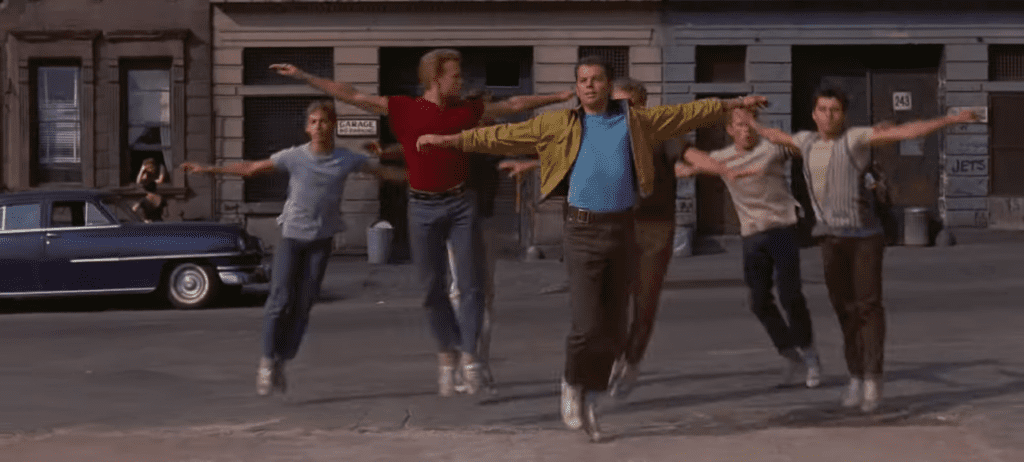
The film hoped to capitalise on the success of the stage musical which had a successful run on Broadway and was received well by audiences and critics alike. Combined with the success of other Hollywood musicals of the same era and the fact that the big studios like MGM were constantly on the look out for new material to adapt for film, West Side Story had the best predetermined ingredients for success, due to the combined talent of various people all working to the same end; to produce the best possible result. In the documentary West Side Memories (USA 2003; Michael M. Arick), an extra feature included on the West Side Story Special Edition DVD, writer Arthur Laurents states “We wanted it to be good, that was more important than being successful.” The facts denote that all the hard work and planning paid off with 11 Academy Awards and the universal critical acclaim that followed. In contemporary terms the film has achieved the status of ‘a classic’ and therefore enjoys a certain immortality in the hearts of audiences and critics alike. Perhaps more so than other successful musical films of the same era, some of which have dated more irrevocably and are thus more forgettable.
For example; My Fair Lady (USA: 1964, George Cukor) another film adaptation of a stage musical. With it’s setting in late 19th Century London and a repertoire of songs that sound like they were written around that time, one might be forgiven for thinking it was released a decade prior, in the era of other more formulaic productions such as Annie Get Your Gun (USA 1950; George Sidney), Oklahoma! (USA 1955; Fred Zinneman), South Pacific (USA 1958; Joshua Logan) or Guys and Dolls (USA 1955; Joseph L. Mankevich). Each of these films shares a certain aesthetical familiarity and formula that is not present in West Side Story. Perhaps this is down to the fact that the story is based in contemporary times, dealing with the important issues of the day, something that would become more prevalent throughout the 1960s.
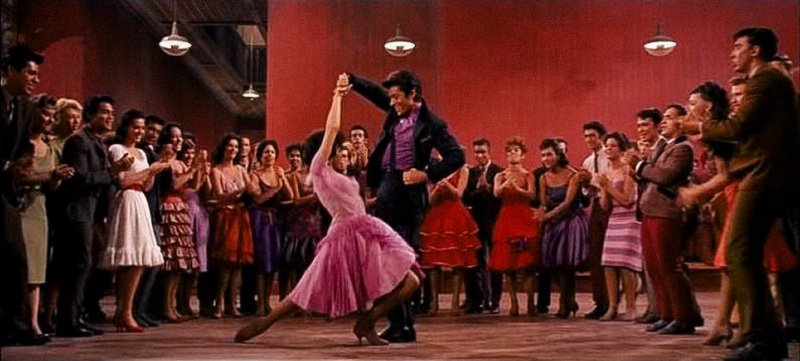
The civil rights movement had been campaigning for over a decade by the time West Side Story was released and the issues of racial segregation and social unrest focussed on in the film could be considered a development in the use of musical film to provide something of a political commentary within the text. Other successful non-musical films of the 1950s such as Rebel Without A Cause (USA 1955; Nicholas Rey) and The Wild One (USA 1953; Laszlo Benedek) are similarly themed and closer in their political agenda to West Side Story than other musical films of the time. I do not suggest that the film hasn’t dated at all; the portrayal of the Puerto Rican ‘Sharks’ has been an area of the film that has been criticised quite severely over the years. Some critics feel that the depiction of the Puerto Ricans is an inaccurate and insulting one and that it is essentially a racist and stereotypical depiction.
For example, the part of Maria, the lead female character is played by actress Natalie Wood, someone who had true star power at the time and was therefore an essential ingredient in Hollywood business terms, but who was certainly not Puerto Rican. Likewise, the character of Bernardo was played by Greek actor George Chakiris who himself had portrayed one of the ‘Jet’ characters in the London production of the show. In his essay West Side Story: A Puerto Rican reading of “America”, Alberto Sandoval Sanchez states “the film projects how the Puerto Rican migration to New York in the 40s and 50s not only usurps the order and the semiotic organisation of the Anglo-Americans, but how it also constitutes a threat for the assumed coherent and monolithic identity of the Anglo-American subject.”[1] I can fully appreciate how the portrayal of the Puerto Rican characters in the film can be viewed in these terms. However, I do not believe that the intention of the film-makers was to belittle the Puerto Rican immigrant population; on the contrary I believe that there is a clear attempt made to show Bernardo, Maria and Anita (the three main Puerto Rican characters) as sympathetic and well rounded characters with equal amounts of positive and negative traits. I would also argue that the ‘white’ characters are not hailed as perfect either, and their portrayal in the film could be seen as equally stereotypical. It is the Jet gang that set upon the character of Anita to gang rape her as she attempts to deliver a message to Tony, their leader.
Perhaps the only other musical film of this time to be subject to racial tension and scrutiny was Porgy and Bess (USA 1959; Otto Preminger). Like West Side Story it is based on a stage musical of the same name, written in 1935 by George and Ira Gershwin with DuBose Heyward. The film encountered trouble in it’s pre-production which followed it through to its release. The casting of black actors was a problem for certain elements of the Hollywood elite and therefore suffered in the box office due to poor promotion and the fact that the Gershwin estate was unhappy with the changes to the original score. The musical itself has drew similar criticism to West Side Story over the years in that it is seen to promote racial stereotypes and re-enforce the prejudice of ignorant beliefs.

West Side Story was originally envisioned as East Side Story, the first draught of the novel by author Arthur Laurents was to have a white catholic boy fall for a Jewish girl, but this idea was later dropped in favour of introducing a Latin element to the story. It could be argued that the music’s composer Leonard Bernstein was eager for this to occur in order to introduce a more jazz influenced and syncopated flavour to the score. The inclusion of this Puerto Rican gang is elemental to the musical direction of the film. The music serves as an aide to narrative cuing, gives a sense of unique identity and signifies emotion and tension. The obscure time signatures employed by Bernstein as a direct result of the Latin as well as other exotic influences, gives the film a unique edge in terms of the interpretive dance we see in conjunction with the score.
Bernstein was a well respected composer with a number of successes under his belt by the time West Side Story came along. His style was thought of as operatic and grandiose as far as ‘the American Musical’ was concerned and therefore, Bernstein was caught between being respected highly as a classically styled composer, but not being taken seriously enough to earn the respect of his piers in the classical realm. In his book America’s Musical Life; Richard Crawford talks about an occasion in 1956 where Bernstein stated on a live broadcast, that it was currently an exciting and classic period for the ‘American Musical’, suggesting that all that was needed was a new ‘American Mozart’ figure to step forth and lead the way to a new era of productivity. He goes on to say…
“Less than a year later, Bernstein himself stepped into the role he had outlined for the new American Mozart. In September 1957, West Side Story, with a book by Arthur Laurents, choreographed by Jerome Robbins, and lyrics by Stephen Sondheim set to Bernstein’s music, opened in New York to the acclaim of critics and audiences.”[2]
Of course, the success of the show and the film cannot just be attributed to just one man. The combined work of lyricist Stephen Sondheim, writer Arthur Laurents and perhaps most notably the contribution of dance choreographer and the films co-director; Jerome Robbins is of equal importance. After developing the original idea of adapting Shakespeare’s play and then working on the development of the stage musical, Robbins was so invested and attached to the project that he was invited by the producers to share a Co-Direction credit with Robert Wise, the thought being that Robbins would handle the dance sequences and Wise would take care of the dramatic scenes. A known perfectionist and tough task master, Robbins’ tireless work with the cast has become Hollywood folklore. The results of this relentless perfectionism are apparent on screen.
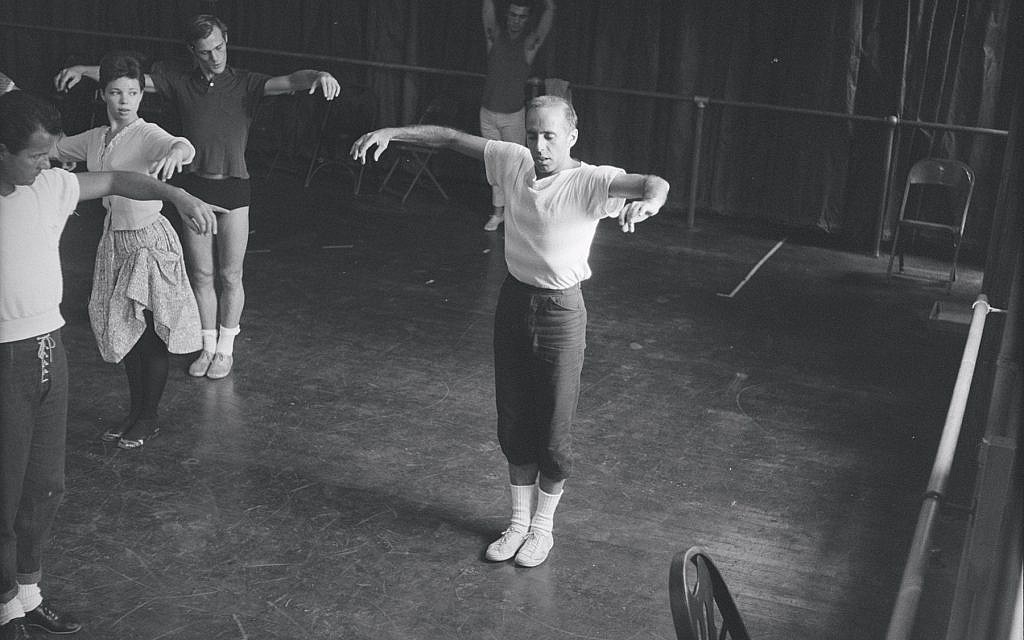
The routines are edgy and bombastic, at times frenzied and stark. This contemporary treatment of the dance numbers was the result of the unique relationship between the composer and the choreographer whom both dabbled in each others handy work, one suggesting something to the other in order to develop the sequences to their full potential. In West Side Memories, Robbins states “Leonard and I have a joke between us; there’s always a step in the ballet he’s suggested and notes in the music that I’ve suggested….I would describe very clearly and very accurately, exactly the type of mood and atmosphere and type of movement I wanted. Now Leonard has a fantastic sense of theatre and he would take it from there and come back with ideas. So that it was kind of a play back and forth between us”. This highlights the collaborative relationship that is necessary to achieve the results that we see in the numbers “America”, “Cool” and the “Prelude” sequence, the latter of which I would like to explore in more detail.
The first four and a half minutes of the film are almost exclusively musical. The very instant the film begins, we hear something before we see anything. A whistle of three notes climbing through the minor seventh of the scale introduces one of the films many leitmotifs. This is repeated three times before the orchestra bursts in with a dramatic overture. As this happens an abstract image fades in which is essentially a pattern of dark lines on a plain background of colour, the colours changing throughout the overture. This instantly affirms West Side Story as a particular type of musical, one that is perhaps more highly evolved or at least attempting to be some kind of hybrid or bridge between musical and opera. This more formal approach creates a certain dramatic atmosphere and allows the audience time to get comfortable. The effect is more akin to listening to a classical concert than it is to the usual opening of a Hollywood musical. The very fact that this introduction is listed as the ‘Overture’ and not a ‘Medley’ is evidence that we are witnessing a more intellectual interpretation of musical film. As the overture reaches its climax, the shot pans out to reveal the films title and then the image begins to cross-fade into a shot of Manhattan island from the air. The music’s fever pitch employs the full power of the orchestra as the original pattern of lines we saw in the abstract image, is revealed to be a correlation of the skyscrapers that shape New York’s famous skyline. This establishing shot tells us we are in modern day New York City.

The overture is finished and a stunning series of aerial shots reveal a birds-eye view of the city. Once again we hear the three note leitmotif being whistled, and as the camera flies over the highways, parks and buildings of New York, we hear two different whistles sounding the motif to one another in varying registers as bongo drums sound frenzied rolls and exotic flourishes, sporadically in between the notes. We also faintly hear diegetic sounds such as traffic and car horns as the shots reveal some famous landmarks such as the Empire State Building and Shea Stadium baseball field. In this sparse and subtle combination of sounds, we are reminded of a jungle with all the birds tweeting in the canopy and drums beating in the distance.

This perhaps suggests that we are now entering the concrete jungle as the camera keeps tracking from right to left (west) and reaches the upper west side of Manhattan. The orchestra is now echoing the leitmotif with horns and percussion as the camera zooms in on a group of young men, huddled together on a basket ball court.

The click of fingers can be heard in time to the rhythm of the music and as the motif builds to a crescendo, a crash zoom suddenly cuts to a close-up shot of Riff clicking his fingers in time. This is cut in perfect co-ordination with the music and is the first evidence of the inspired use of editing which is also a key element to the film’s success. In time with each further click of the fingers, the camera pans to the right to reveal two more Jet characters; Ice and Action. The use of this style of editing, where the camera moves in time to the music and also acts as a further narrative aid, is one of the intrinsic elements of the film and was thought out with painstaking precision in the filming process. Both directors Robbins and Wise chose to shoot all the action from as many angles as possible, giving the film a truly fluid and seamless flow which compliments the complex and theatrical dance routines.
In this way the film is developing the performances of the stage show into a more illicit and structured experience. One where we are exposed to a multitude of angles and camera movement which pulls us further in to the action and invites our emotional investment deeper in to the narrative.
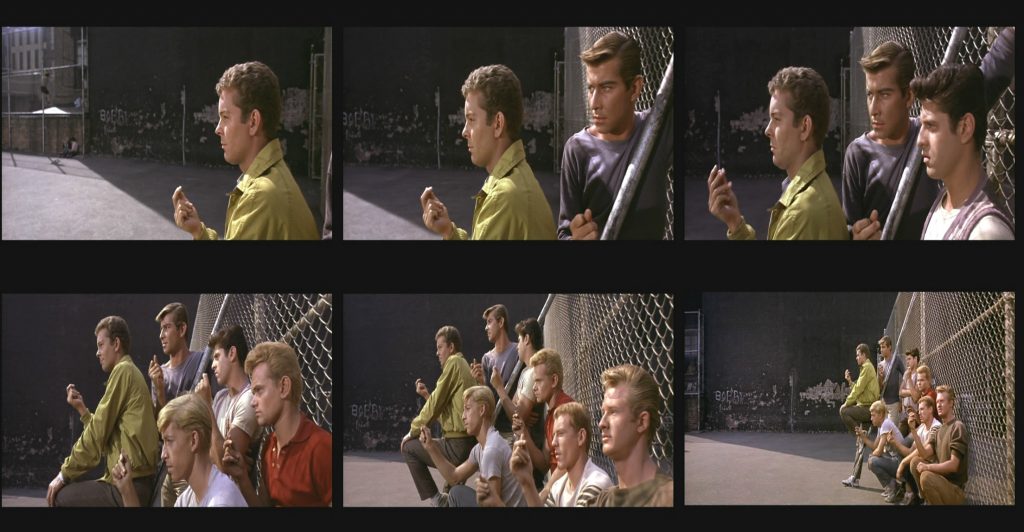
There follows a series of quick jump cuts in which more members of the Jets gang are revealed via the use of a wider variation of the same shot. Each gang member laconically clicks his fingers in time to the tempo, surveying the area as they languish against the fence. This has introduced us to the first gang and their unity is displayed through the fact that they are all clicking their fingers in time with one another.
The next shot reveals the pecking order of the gang and there social status as the local tough guys, all without the use of dialogue. The cool disposition of the gang is interrupted by a baseball hitting the fence next to one of their heads. As the ball impacts on the fence and rattles it, the music abruptly stops and the character Action catches the ball on the rebound. The ball’s owner stands to attention before the gang as they all stare at him with a scowl. The leader Riff, looks at Action who now holds the ball, and with a single head motion towards the balls owner, he is commanding Action to return it. Action throws it back as the music begins again and Riff immediately begins to click his fingers in time once again. The rest of the gang join in and once again with another swift head movement, Riff indicates “Let’s go! Follow me!” to the rest of the gang.
Here Riff is confirmed as the leader of the gang. A tracking shot follows the Jets across the basket ball court from outside of the fence, as the tempo of the music increases slightly and the orchestra interjects various short three note phrases which build and grow as we cut to a high shot of the gang walking across the court. There follows a sequence in which the gang walks directly through a game of basket ball that two other boys are playing. They take the ball for themselves, passing it between them as the main theme now bursts in and is played by the entire orchestra. Its dissonant melody and punchy rhythm invoke a sense of youthful bravado and it achieves edginess through its peculiar time signature. As Riff returns the basket ball to one of the boys, the music dies down to a menacing and ominous level using the bass instruments such as the tuba, reinforced by the strings.

The movement now becomes more like a ballet in musical as well as dance terms. A wide tracking shot follows the gang walking down the street looking tough. The music is now building up a plethora of contrapuntal melodies in a swirling repetition as various Jets begin to pirouette like ballet dancers. This is done in time with the dominant accents in the music and in juxtaposition to the steady flowing tracking shot. The effect is extremely powerful in pulling the audiences focus towards the music and how it is being interpreted by the players in their movements. This is intended to echo their feelings as they literally soar around their territory like eagles, on the wing.
The camera tracks back as the Jets cross the street. The melody is becoming chaotic and intricate as different sections of the orchestra weave their way through the complicated modes of scales. Here is further evidence of Bernstein’s genius as a composer. These are not tunes you can easily repeat like one might hum ‘Singin’ in the Rain’. On the contrary, the combination of complex time signatures and equally complex scale modes give the score an exciting and very contemporary feel. It is very jazz influenced and shares similarities with other ethnic music, such as Romanian folk music which traditionally employs irregular time signatures such as 7/8 and 12/8. The main theme is once again reinforced and is brought back with even more gusto and significance as the gang dance in unison across the street, led by their smiling and confident leader. As the Jets spin into the air in formation, we cut to a high shot which reveals the word JETS written on the concrete beneath their feet.

This establishes the gang’s name and the fact that they are on their own turf. We then cut away to a panning shot in which the Jets are stopped in their tracks by the presence of an unwelcome party. Enter Bernardo, almost squeezed out of the shot by the gang, he stands defiant and introduces disequilibrium to the scenario.

The music fades back to a percussive and impending level as Bernado is pursued and taunted by two of the Jets. Drums echo the rhythm of the theme in the background as we establish that Bernado is an enemy of the Jets. The Jets display their predatory nature by blocking his path and making a fist at him, which is ‘mickey-moused’ by a trill of notes on the saxophone. The next shot previews the films wonderful use of colour in a close-up shot of Bernado pounding his fist against a red brick wall. This clearly signifies his rage and anger at the Jets and their behaviour towards him.

We now follow Bernado down the other side of the street as we did with the Jets. He clicks his fingers in time with the score as Riff did and is joined by two members of his gang who do likewise. The tempo increases and Bernado and his friends begin a series of spectacular moves that combine classical ballet moves with modern expressionist dance, creating rivalry that is fought out through dancing. They make fists and kick out their legs in an aggressive and challenging style, equalling the Jets’ moves and showing them to be worthy competition in this ‘dance’ battle for the streets.

The main theme is repeated as the three Sharks surround two Jets who have just stolen an orange from a fruit stand. The idea that the two gangs are opposed is now firmly established and reinforced over the following chase sequences, which show each gang trying to outwit and belittle the other via a series of traps and tricks. All of this is choreographed to perfection and is shot with precise and innovative techniques. The score echoes the frenzied action, always exciting and entertaining and above all, it observes the rule of invisibility. It effortlessly weaves the series of images together and serves the narrative where appropriate. The action culminates in a gang brawl which is broken up by the police and signifies the end of the prelude. Now 15 minutes into the film, the first dialogue is spoken, yet we already have a very clear picture of life on the streets of the west side, without any real lines being uttered.
Jerome Robbins’ tireless and irrepressible enthusiasm and drive were instrumental in achieving the truly mesmeric effect that we see on screen throughout the film’s musical sequences. It is also the reason he was asked to leave the production before principle photography was completed. The first location shoot in New York City was scheduled for two weeks. Due to some rain and Robbins’ constant desire to re-shoot scenes again and again, the budget began to sky rocket and producers and investors made the decision to remove Robbins and leave the rest of production to the more business savvy Robert Wise. However, as a testament to Robbins, Robert Wise insisted that he be present for the editing process and made sure he was at the Academy Awards to collect the Oscars along with the rest of the crew.
The story itself deals with many core emotions, for example the love between the two central characters, with all its complexities and intricacies, some too unfathomable to be explained by words. This is where the film shines, in its ability to articulate that which vocabulary cannot describe. Hatred, rivalry, youthful rebellion, violence, racism, happiness and self-expression must also be interpreted with a degree of verisimilitude and at times without the power of dialogue. On both a conscious and unconscious level the audience must be able to interpret the narrative through the combination of music and movement as equally as they interpret the sung or spoken word. This is where the film truly shines and is somewhat unique. This is after all, is a story of the human condition and its capacity for both love and hatred in equal measure. Few musicals before West Side Story dealt with such hard hitting and topical issues and even fewer musicals have used the combined power of dance and music in quite the same extent. The combined talent of its creative producers is a unique example of a collaboration that is rarely seen to such a high standard. Affirming this thought in her thesis about the film adaptation, Megan Woller states “Four great talents of musical theatre came together to create a well-crafted and yet timeless musical. Despite the problems and static quality of the 1961 film, it remains a creative adaptation that in many ways remains relevant.”[3]
Ultimately it is the music and the imagery that has stood the test of time and is measured by its own ability to engulf us in the story and invest our emotion in to the film as an audience.
[1] Alberto Sandoval Sanchez, West Side Story: A Puerto Rican reading of “America”, at http:www.ejumpcut.org/archive/onlinessays/JC39folder/westSideStory.html (accessed on 6th January 2013)
[2] Richard Crawford, America’s Musical Life, (London: Norton, 2001), p.771
[3] Megan Bolander Woller, ‘A Place for West Side Story: Gender, Race and Tragedy in Hollywood’s Adaptation’ at http:www.ideals.illinois.edu/bitstream/handle/2142/18412/Woller_Megan.pdf accessed on 4th January 2013
Bibliography:
Richard Crawford, America’s Musical Life (London: Norton, 2001)
K. J. Donnelly, Film Music: Critical Approaches (Edinburgh: University Press, 2001)
Russell Lack, Twenty Four Frames Under: A Buried History of Film Music (London: Quartet,2002)
Jeff Smith, The Sounds of Commerce (Chichester, Columbia University Press, 1998)
Filmography:
My Fair Lady (USA 1964; George Cukor)
West Side Story [2003 Special Edition DVD] (USA 1961; Jerome Robbins & Robert Wise)West Side Memories (USA 2003, Michael M. Arick)
Read more of our film essays here and and please join us on Facebook and Twitter.
If you enjoy our content, please consider supporting us here.

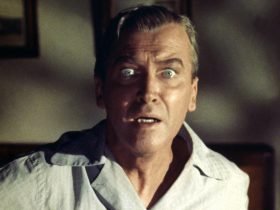
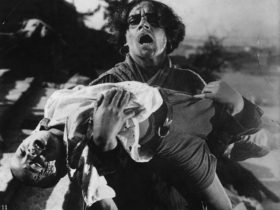
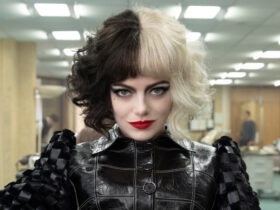
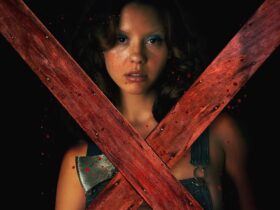
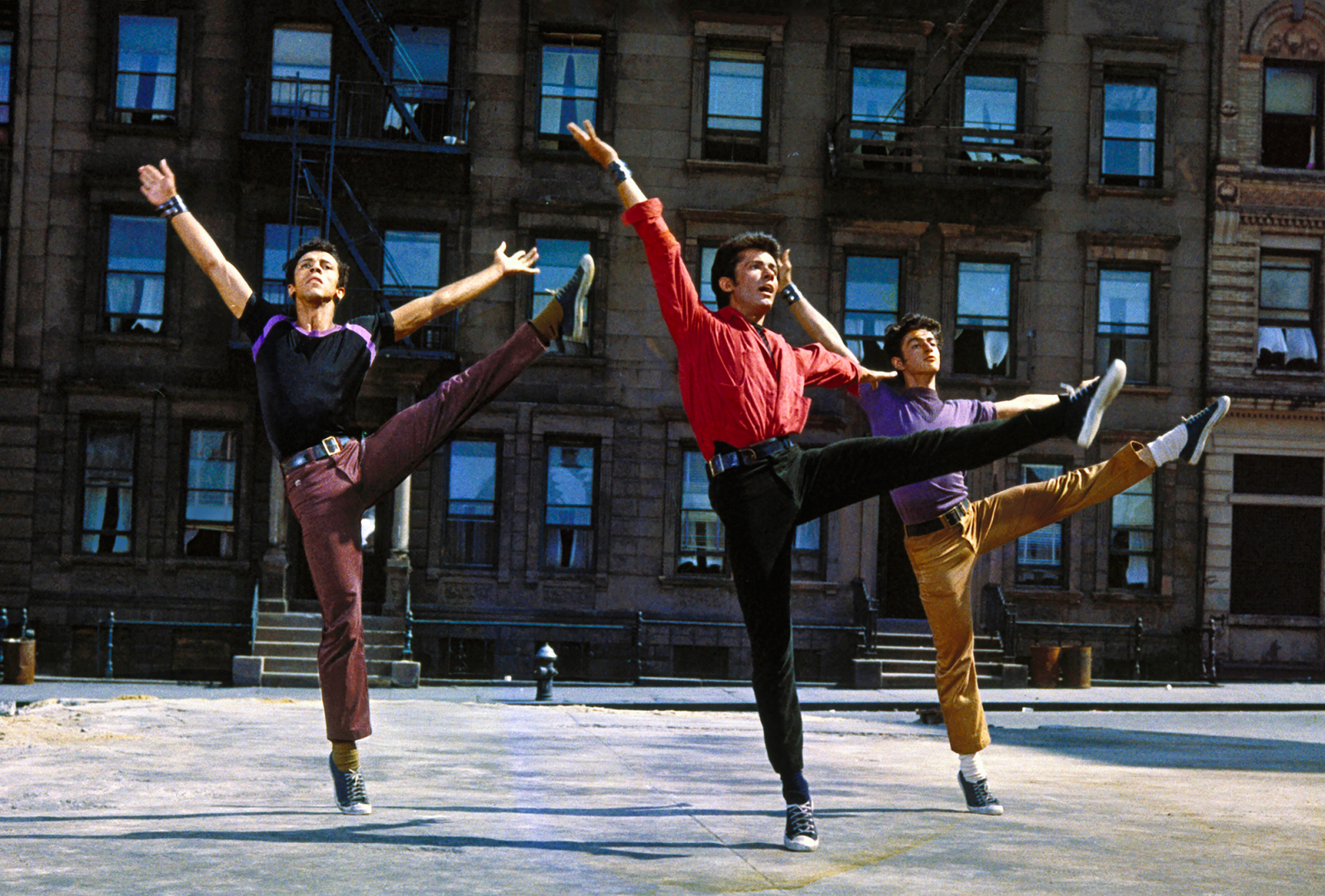

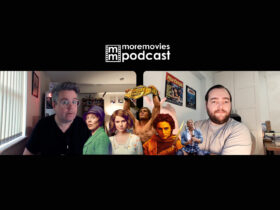
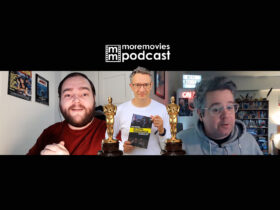
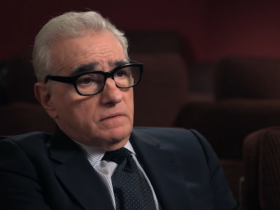
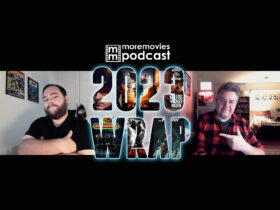
1 Comment